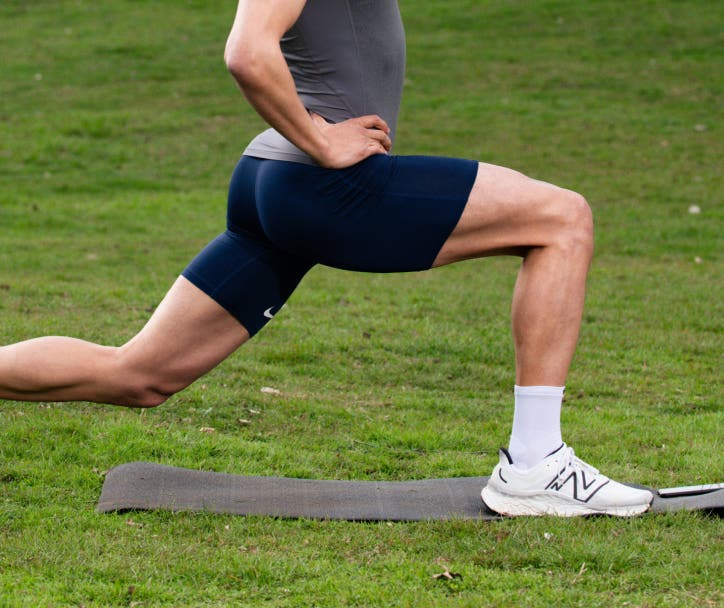In the realm of running, "cross-training" has gained a lot of traction in recent years—with good reason. While running remains a cornerstone of training regimens, integrating other forms of exercise can offer a myriad of benefits, from injury prevention to enhanced performance.
In this comprehensive guide we’ll explore what cross-training entails, its numerous advantages, examples of effective cross-training activities, and how to seamlessly incorporate it into your running routine. Let’s hit the ground running.
What is cross-training for runners?
Cross-training involves supplementing your training routine with activities other than running. These activities encompass a variety of exercises that target different muscle groups and movement patterns than those primarily used in running. By switching things up and diversifying your workouts, you can enhance your overall fitness, reduce the risk of overuse injuries, and improve performance.
What are the benefits of cross-training?
Injury prevention
Hitting your stride can take a toll on your body. Cross-training alleviates that repetitive strain by providing opportunities for low-impact exercise.1
Activities such as swimming or cycling offer a break from the constant pounding on the pavement, reducing the risk of overuse injuries like stress fractures or tendonitis, while building strength to ensure that the impact of running is handled properly.2
Rehabilitation
If an injury has you sidelined from running, cross-training can help you recover and prevent major losses in cardiovascular fitness. Low-impact activities like swimming or elliptical training allow injured runners to stay active without exacerbating their condition, promoting faster rehabilitation.
Active recovery
Cross-training serves as an effective tool for active recovery between intense running sessions. Engaging in light activities such as walking or yoga helps loosen tight muscles, enhance blood flow, and alleviate post-run soreness, speeding up the recovery process.
Improved cardiovascular endurance
While running primarily targets cardiovascular fitness, cross-training activities like cycling, rowing, or strength training provide alternative avenues for improving both aerobic and anaerobic capacity. By challenging the heart, muscles, and lungs in different ways, you can enhance overall endurance, leading to better performance on the road or trail.
Boosts motivation
Tired of the same old running loop day in and day out? Diversifying your workouts through cross-training is your answer. Not only does it prevent monotony and burnout, but it also helps keep your enthusiasm for exercise alive. Exploring other sports and activities introduces novelty and excitement into your routine, reigniting motivation and fostering a well-rounded approach to fitness.
This is one of the most overlooked aspects of any fitness routine: variety.

Examples of cross-training activities
The options for cross-training are endless and it’s also a great way to focus on hitting your Base. Added bonus – you can boost your motivation (or add a competitive edge) by building up your Base streak.
Read on to discover more activities to supplement your stride.
Hiking, walking, swimming
Swimming engages the entire body, promoting cardiovascular fitness while minimizing stress on the joints. The buoyancy of water reduces impact forces, making it an ideal cross-training activity for runners recovering from injuries or looking to prevent them.
Walking and hiking strengthen lower body muscles, including the quadriceps, hamstrings, and calves, which are essential for running performance and injury prevention. These activities also improve aerobic capacity and endurance, translating to enhanced performance during runs.
Resistance training
Strength training, particularly exercises like Lunges and Squats, plays a crucial role in enhancing running performance and reducing the risk of injury. These exercises target key running muscles, including the quadriceps, hamstrings, glutes, and calves, strengthening them to withstand the repetitive impact of running.3
Incorporating strength training into a running routine improves running economy and efficiency, leading to better performance. Moreover, strengthening the muscles around the joints helps maintain proper biomechanics,4 reducing the likelihood of overuse injuries such as patellofemoral pain syndrome and iliotibial band syndrome.
Cycling (indoor or outdoor)
Cycling is a highly effective cross-training activity for runners due to its ability to strengthen leg muscles and provide a cardiovascular workout with minimal joint strain. Cycling primarily targets the quadriceps, hamstrings, and calves, which are essential for running performance. By pedaling against resistance, cyclists develop muscular endurance and power, translating to improved running performance.
Moreover, cycling offers a low-impact alternative to running, making it suitable for runners recovering from injuries or looking to reduce the risk of overuse injuries.
Rowing
Rowing engages multiple muscle groups simultaneously, making it an excellent cross-training activity for runners. Rowing primarily targets the upper back, shoulders, core, and legs, providing a comprehensive full-body workout. By incorporating rowing into your training regimen, you can improve cardiovascular fitness, muscular strength, and endurance.
As with running, rowing also requires full-body coordination, which is essential for maintaining proper running form and preventing injuries. Additionally, the rhythmic nature of rowing promotes mental focus and relaxation, making it an effective stress-relief activity for runners, or anyone.
Mobility, stretching, and foam rolling
Maintaining flexibility and reducing muscle tightness are crucial aspects of injury prevention and performance optimization for runners. Mobility and stretching exercises are effective techniques for achieving these goals by enhancing range of motion, reducing muscle stiffness, and improving muscle function and mechanics.
Regular mobility work can alleviate muscle soreness, decrease the risk of injury, and improve athletic performance. As you stretch, try adding a foam roller for an extra element of relaxation.

When to cross-train
Cross-training can be integrated into a running schedule in various ways, depending on individual goals, fitness levels, and training objectives. Here are a few scenarios:
Active recovery days
Incorporate cross-training activities like swimming or gentle yoga on days following intense workouts or long runs to facilitate recovery while maintaining activity levels. Strengthen your muscles and improve your range of motion by adding resistance training 1-2 times a week.
Pre/post run
Before your long run, hop on the bike for 10 minutes or more. Alternatively, implement a quick strength session when you get back. Cross-training can serve as an excellent warm-up, cool-down, or finisher to any run.
Injury rehabilitation
If sidelined by a running-related injury, replace running sessions with low-impact cross-training activities like cycling or elliptical training to maintain cardiovascular fitness, along with targeted strength training to aid in the recovery process.
Making cross-training part of your routine
To effectively integrate cross-training into your running schedule, consider the following strategies:
- Set clear goals: Identify specific objectives for cross-training, whether it's injury prevention, rehabilitation, or performance enhancement.
- Be consistent: Dedicate regular sessions to cross-training activities, ensuring they complement your running routine rather than take away from it.
- Listen to your body: Pay attention to signs of fatigue or overtraining, and adjust the intensity and frequency of cross-training accordingly.
- Stay flexible: Be open to trying new activities and adjusting your cross-training regimen based on your body's feedback and performance metrics.
Let’s recap
Cross-training is a valuable tool for runners seeking to optimize their performance, prevent injuries, and maintain long-term fitness. By incorporating diverse activities into your training routine, you can enhance overall strength, endurance, and resilience, ultimately becoming a more well-rounded and resilient athlete on the run.
Sources
[1] Boullosa, D. et al. (2020) Factors affecting training and physical performance in Recreational Endurance Runners, MDPI. Available at: https://www.mdpi.com/2075-4663/8/3/35 (Accessed: 22 March 2024).
[2] Vincent, H. K., Brownstein, M., & Vincent, K. R. (2022). Injury Prevention, Safe Training Techniques, Rehabilitation, and Return to Sport in Trail Runners. Arthroscopy, Sports Medicine, and Rehabilitation, 4(1), e151–e162. https://doi.org/10.1016/j.asmr.2021.09.032
[3] Prieto-González, P., & Sedlacek, J. (2022). Effects of Running-Specific Strength Training, Endurance Training, and Concurrent Training on Recreational Endurance Athletes’ Performance and Selected Anthropometric Parameters. International Journal of Environmental Research and Public Health, 19(17), 10773. https://doi.org/10.3390/ijerph191710773
[4] Šuc, A., Šarko, P., Pleša, J., & Kozinc, Ž. (2022). Resistance Exercise for Improving Running Economy and Running Biomechanics and Decreasing Running-Related Injury Risk: A Narrative Review. Sports, 10(7), 98. https://doi.org/10.3390/sports10070098